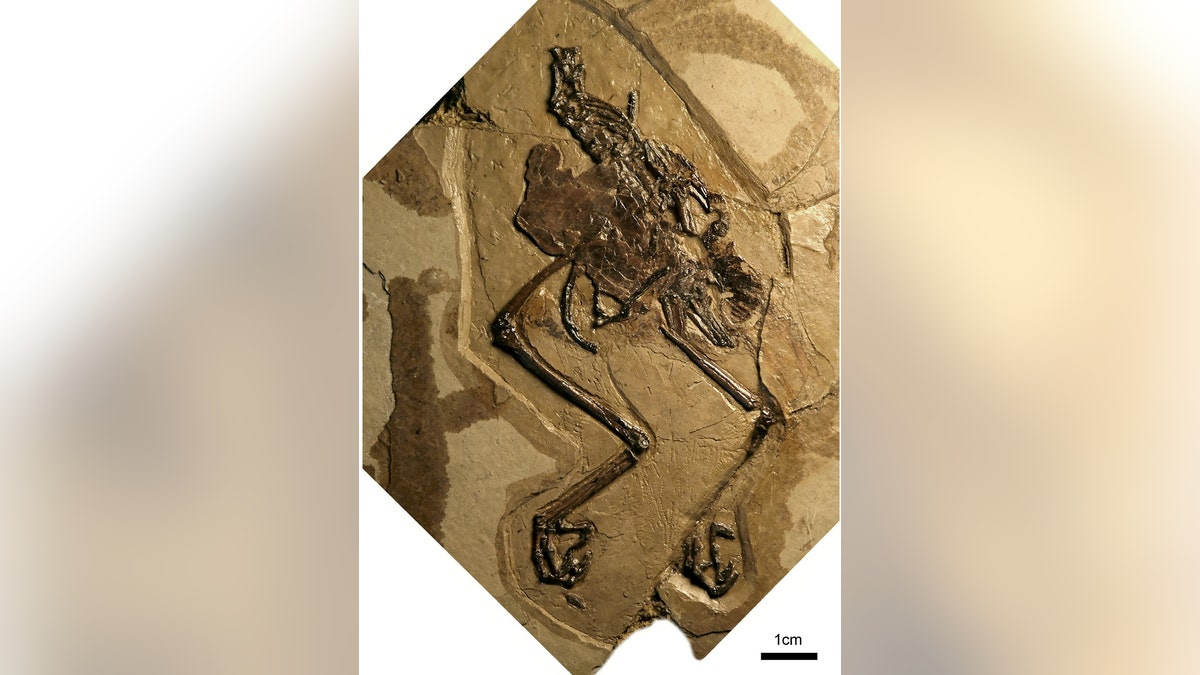
Scientists say that the "incredibly well preserved" find, dating back to the time of the dinosaurs, sheds new light on the reproduction of birds. The specimen, representing a new species called Avimaia schweitzerae, was discovered in 110-million-year-old deposits in northwestern China. (Credit: SWNS)
A stunning new discovery is shedding light on the first-ever bird fossil found with an egg preserved inside of it.
The find, made in 110-million-year-old deposits in northwest China, is of a new species known as Avimaia schweitzerae and the fossil has been described as "incredibly well preserved." The new species belongs to the group known as Enantiornithes, which were fairly common in the Cretaceous period, living alongside dinosaurs.
However, the fossilized egg may have resulted in the death of the so-called mother bird, researchers said.
WOOLY MAMMOTH CELLS BROUGHT BACK TO LIFE IN SHOCKING SCIENTIFIC ACHIEVEMENT
"The egg shell consists of two layers instead of one as in normal healthy bird eggs, indicating the egg was retained too long inside the abdomen," Dr. Alida Bailleul said in comments obtained by SWNS.
"This condition often occurs in living birds as a result of stress," she continued. "In addition, the eggshell preserved in Avimaia was extremely thin – thinner than a sheet of paper – and did not show the correct proportions of healthy eggs. These abnormalities suggest that the preserved egg may have been the cause of death of this 'mother bird.'"
Bailleul added that this type of abnormality has been seen elsewhere in the animal kingdom, including in sauropod dinosaurs, "as well as in many fossil and living turtles."
Since the fossil was crushed flat, it was only after the researchers extracted a small fragment and analyzed it did they realize the unusual tissue was an egg. The specimen contains not only the eggshell itself, but also the membrane and the cuticle, which are largely made up of proteins and other organic materials.

The specimen, representing a new species called Avimaia schweitzerae, was discovered in 110-million-year-old deposits in northwestern China. It belongs to a group called the Enantiornithes - "opposite birds" - which were common all around the world during the Cretaceous Period and lived alongside the dinosaurs. (Credit: SWNS)
"SEM reveals that the cuticle consists of nanostructures resembling those found in neornithine eggs adapted for infection-prone environments, which are hypothesized to represent the ancestral avian condition," the study's abstract reads.
Dr. Jingmai O’Connor, a co-author on the study, said that the morphology would be expected for birds that bury their eggs, but this discovery "also supports the hypothesis that a cuticle with protective spherules represents the ancestral condition for avian eggs."
CLICK HERE TO GET THE FOX NEWS APP
"Avimaia is the only Mesozoic fossil in which additional morphological evidence of reproductive activity - i.e. the egg - supports the identification of medullary bone," O'Connor continued. "This new specimen is arguably one of the most interesting Cretaceous fossil birds yet discovered, providing more reproductive information than any other Mesozoic fossil bird."
The study was published in Nature Communications.




















